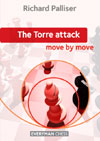
The Torre Attack move by move by
Richard Palliser
2012
Everyman
Chess
http://www.everymanchess.com
302 pages
Price € 23,75
ISBN 978-1-85744-686-9
The Torre Attack is characterized by the moves 1.d4 Nf6 2.
Nf3 e6 3.Bg5 and statistical analysis shows that it is not particularly
advantageous for
white, but as we can learn from Richard Palliser in this book black has
to take care!
For example after 1.d4 Nf6 2.Nf3 g6 3.Bg5 Bg7 4.Nbd2 0-0 white must
play 5.c3! and after 5….d5 6.e3 Nbd7 7.Bd3!? we reach the interesting
model
game,Bauer – Smirin,European Team Championship,Porto Carras 2011.
Interesting is the text from Palliser after the move 7.Bd3!? “This
trendy move is likely to surprice a booked up opponent.For years it was
thought
that if white wanted to play for an advantage,{he had to try
7.Be2,avoiding any potential for with e5-e4}7….Re8 8.b4!?,allowing
black to
occupy the centre in return for beginning a queenside offensive.The
text looks fairly harmless,but see what follows.
Yes this 32 move game is good for 13 pages of highly instructive text!
This move to move book only holds 24 model games but it is good for
over 300 pages of text.
The first 132 pages are mainly devoted to King’s Indian related lines
and the remaining pages go to lines with 2….e6.
Some times it can get sharp as we can see in game 19: Akopdzhanyan,GD -
Stavnichuk,Anatoly P [A46]
URS-chT10 corr9194 Russia, 1991
1.d4 Nf6 2.Nf3 e6 3.Bg5 c5 4.e3 Qb6 5.Nbd2 Qxb2 6.Bxf6 gxf6 7.Be2 cxd4
8.Rb1 Qc3 9.0-0 Qc7 10.Ne4 Be7
11.Qxd4 Qd8 12.Nd6+ Bxd6 13.Qxd6 Nc6 14.Rfd1 Rg8 15.Nd4 Qe7 16.Nb5 Kf8
17.Qd3 Kg7 18.Nd6 Rb8
19.Rb5 Kh8 20.Rh5 Rg7 21.e4 b6 22.f4 Bb7 23.Qc3 Ba8 24.Bf3 Rbg8 25.Rd3
Na5 26.Nc8 Qd8 27.Nxa7 Nb7 28.Nc6 1-0.
The bold queen move 4….Qb6 did receive a lot of attention after Torre’s
crushing win against Lasker but it nowadays seldom seen.
Conclusion: Truly a very instructive
work!
The Four Knights move by move by Cyrus
Lakdawala
2012
Everyman
Chess
http://www.everymanchess.com
368 pages
Price € 24,95
ISBN 978-1-85744-693-7
Cyrus Lakdawala does
not offer the reader an repertoire but a complete move to move coverage
of the Four Knights,where the former National
Open covers with instructive words the following lines:
Four Knights Spanish Symmetrical variation,Rubenstein Gambit,Fourmove
Alternatives,Four Knights Scotch,Belgrade Gambit,Glek Variation,Third
Move Alternatives
for black and the Three Knights versus Petroff.
All material is well explained at the hand of 52 model games as for
example the following one from Zaikoc which reminds me at the
Latvian Gamit: Esserman,Mark (2394) - Zaikov,Oleg (2385) [C46] USA tt
ICC INT (6), 05.10.2009
1.e4 e5 2.Nf3 Nc6 3.Nc3 f5 4.d4 fxe4 5.Nxe5 Nf6 6.Bc4 d5 7.Nxd5 Nxd5
8.Qh5+ g6 9.Nxg6 hxg6 10.Qxg6+ Kd7 11.Bxd5 Nxd4
12.Bg5 Qe8 13.Bf7 Qe5 14.0-0-0 c5 15.c3 Kc7 16.cxd4 cxd4 17.Kb1 Bf5
18.Rc1+ Kd7 19.Qf6 Bg7 20.Be6+ 1-0.
The following model game is related to the famous game between la
Bourdonnais and McDonnell: Todorcevic,M - Damljanovic,B [C46]
Palma de Mallorca op, 1995
1.e4 e5 2.Nf3 Nc6 3.Nc3 Be7 4.d4 d6 5.Bb5 exd4 6.Qxd4 Kf8 7.Qe3 Nf6
8.0-0 h5 9.h3 h4 10.b3 Nb4 11.Qd2 d5 12.Ba3 c6
13.e5 Ne8 14.Be2 a5 15.Na4 b5 16.Nb2 Nc7 17.c3 Nba6 18.Bxe7+ Qxe7
19.Nd4 Bd7 20.f4 Nc5 21.Bf3 g6 22.Rae1 N5e6
23.Nd3 Ng7 24.Bg4 Bxg4 25.hxg4 c5 26.Nc2 c4 27.Nf2 Qc5 28.Nd4 b4 29.f5
gxf5 30.gxf5 Rh5 31.Ng4 bxc3 32.Qe3 cxb3
33.Nf6 Ke7 34.Nxh5 Nxh5 35.Rc1 Nb5 36.f6+ Kd7 37.e6+ fxe6 38.Qxe6+ Kc7
39.Qe7+ Qxe7 40.Nxb5+ Kb6 41.fxe7 Kxb5
42.Rf8 b2 43.Rcf1 Ng7 44.Rxa8 Kc4 45.Rb1 a4 46.Kh2 Kd3 47.a3 d4 48.Rd1+
Ke4 49.Re1+ Kd5 50.Rd8+ Kc5 51.Rg8 d3
52.Rxg7 c2 53.e8Q c1Q 54.Qe5+ 1-0,but here the white pieces come first.
Conclusion: Very interesting made!
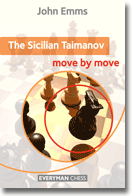 The Sicilian Taimanov
move by move by John Emms
2012
Everyman
Chess
The Sicilian Taimanov
move by move by John Emms
2012
Everyman
Chess
http://www.everymanchess.com
368 pages
Price € 24,95
ISBN 978-1-85744-682-1
John Emms digs with move to move annotations and didactic
analyses into the world of the Sicilian Taimanov,that runs with
the moves:1.e4 c5 2.Nf3 e6 3.d4 cxd4 4.Nxd4 Nc6.
Nowadays we play after 1.e4 c5 2.Nf3 e6 3.d4 cxd4 4.Nxd4 Nc6 5.Nb5 d6
6.c4!
The great Bobby Fischer played against Petrosian,Buenos Aires 1971,
1.e4 c5 2.Nf3 e6 3.d4 cxd4 4.Nxd4 Nc6 5.Nb5 d6 6.Bf4 e5 7.Be3 Nf6 8.Bg5
Be6 9.N1c3 a6 10.Bxf6 gxf6 11.Na3 d5
12.exd5 Bxa3 13.bxa3 Qa5 14.Qd2 0-0-0 15.Bc4 Rhg8 16.Rd1 Bf5 17.Bd3
Bxd3 18.Qxd3 Nd4 19.0-0 Kb8 20.Kh1 Qxa3
21.f4 Rc8 22.Ne4 Qxd3 23.cxd3 Rc2 24.Rd2 Rxd2 25.Nxd2 f5 26.fxe5 Re8
27.Re1 Nc2 28.Re2 Nd4 29.Re3 Nc2 30.Rh3 Rxe5
31.Nf3 Rxd5 32.Rxh7 Rxd3 33.h4 Ne3 34.Rxf7 Rd1+ 35.Kh2 Ra1 36.h5 f4
37.Rxf4 Rxa2 38.Re4 Nxg2 39.Kg3 Ra5 40.Ne5 1-0.
As Emms explains between the lines Fischer played 16.Rd1 and after
16…Bf5 17.Bd3 Bxd3 18.Qxd3 Nd4 19.0-0 he’d escaped intact
and even went to win.
Petrosian’s 11…d5 didn’t get the reward it deserved, but it didn’t take
long for major improvements to be found.
Probably the most convincing one is after Emms: 16….Rxg2! with
advantage to black, eg 17.Ne4 Qb6! 18.Qe3 Qxe3+
19.fxe3 Bg4! Or 17.Qe3 Nd4 18.Kf1 Nf5!
But I found these moves also in the book
Russians versus Fischer from Plisetsky and
Voronkov,Everyman Chess 2005.
These Move to Move openings book from Everyman Chess are perfect for
players from 1500 to all the way up to 2300 or so.
But how stronger the player how less you get out of it, and the
questions between the lines can get then quite disturbing.
Covered are the following chapters in this book:White plays 1.e4 c5
2.Nf3 e6 3.d4 cxd4 4.Nxd4 Nc6 5.Nc3 Qc7 6.Be2,Main
Lines, Alternative lines, White plays 6.Be3 and Bd3.
The English Attack: plays 1.e4 c5 2.Nf3 e6 3.d4 cxd4 4.Nxd4 Nc6 5.Nc3
Qc7 6.Be3 a6 7.Qd2,White plays 6.f4,The Fianchetto
Variation plays 1.e4 c5 2.Nf3 e6 3.d4 cxd4 4.Nxd4 Nc6 5.Nc3 Qc7
6.g3,White plays 5.Nb5 and other lines as 5.c4.
Interesting to mention is that 5.Nc3 is the most popular move in this
position, a Sicilian Taimanov player would expect to face
it around 75% of the time 5.Nb5 comes a distant second with around 15%.
Included in this book are 39 extensive analysed model games.
Conclusion: Interestingly written by an well known expert!
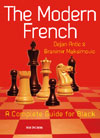
The Modern French A Complete Guide for Black
by Dejan Antic & Branimir Maksimovic
2012
New in Chess
http://www.newinchess.com/
365 pages
Price € 28,95
ISBN:
978-90-5691-39-91
The two chess cracks Grandmaster Dejan Antic and his companion
IM Branimir Maksimovic don’t only provide the reader with a
detailed coverage of strategic concepts and attacking
plans, but above all offer a fascinating repertoire for black on the
black side of the board.
This all is based on lines as the fascinating McCutcheon: 1.e4 e6 2.d4
d5 3.Nc3 Nf6 4.Bg5 Bb4 5.e5 h6 6.Bd2 Bxc3 7.bxc3 Ne4
8.Qg4 Kf8 9.Bd3 Nxd2 10.Kxd2 c5 11.Nf3 c4 12.Be2 Nc6 13.h4 Qa5!?.
The material to the McCutcheon is very extensive and reminds me at the
better works from Moles and Kindermann!
Various alternatives are covered here and the both authors are not
afraid to throw there French secrets on the street.
In big lines the following lines are covered: King’s Indian Attack, The
Exchange Variation, The Advance
Variation,The Tarrasch Variation and the McCutcheon.
The material is not covered as model game but all in old fashion
readable theory lines!
In the Tarrasch,they go for the move 1.e4 e6 2.d4 d5 3.Nbd2 Be7,hoping
to transpose in the 3…Nf6 and c5 lines.
The Milner Barry Gambit: 1.e4 e6 2.d4 d5 3.e5 c5 4.c3 Nc6 5.Nf3 Bd7
6.Bd3 cxd4 7.cxd4 Qb6 8.Nc3 Nxd4
9.Nxd4 Qxd4 10.0-0 a6 11.Kh1 Qxe5 is not considered as correct but the
words from on it are instructive:
Of all the continuations we suggest this is the weakest but still a
very dangerous one.White gives away
his second central pawn in order to maximise the power of his pieces.
He also takes into account that his opponent is spending on queen moves.
After 11…Qxe5 Snatch the central pawn every time you can! It’s an old
adage ,and very applicable in this position.
Generally, gambits involving wing pawns are moree dangerous,
because they are less valuable than central pawns.
Conclusion: A super repertoire book on the French!
 Grandmaster
Preparation - Calculation (hardcover) by Jacob Aagaard
Quality Chess
304 pages
Price €29,99
ISBN 978-1-907982-31-6
Grandmaster
Preparation - Calculation (hardcover) by Jacob Aagaard
Quality Chess
304 pages
Price €29,99
ISBN 978-1-907982-31-6
Grandmaster Jacob Aagaard covers in this eye catching hard cover work
different thinking methods as Candidates, Combinations, Prophylaxis,
Comparison, Elimination, Intermediate Moves, Imagination etc.
All well packed in a Hugh collection exercises, yes Aagaard is the man
of exercises.
These exercises are certainly no easy walk throws no the reader is
forced to think and play like a real master.
Aagaard is good with the pen too, for example I enjoyed his words about
Imagination:
Imagination in chess is hard to define beyond the discovery of strong
ideas that come a surprise to most.
But you can also look at is as going beyond the obvious moves in
order to see the truth nature of the position.
This can be the activation of pieces overriding a recapture, it can be
favouring a pawn over a piece, and it can be putting a piece on a
square that is
seemingly not available, but where it cannot be captured and so on.
Imagination can certainly be trained. Like candidate moves, the
training method is before anything else, to be aware of the need for
training it.
What I think is quite important to understand to understand is that
imagination does not arise from some gene we acquired at birth, nor
does it arise from an
alcohol fuelled lifestyle, as some people do seem to think.
Imagination is a combination of awarness of the real aspects of the
postion over more mundane human considerations.
Imagination in chess is not different from logic in chess;it is simple
one of many reflections of it.
And this is the reason it can be trained, because what we train when we
train imagination is awareness of the basics of
chess: weakness,the opponent’s ideas,piece placement and pawn structure.
Included is useful name index but no biography.
Conclusion: A master piece on chess
training!
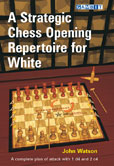 A strategic chess
opening repertoire for white by John Watson
2012
Gambit Publications Ltd
A strategic chess
opening repertoire for white by John Watson
2012
Gambit Publications Ltd
http://www.gambitbooks.com
E-mail info@gambitbooks.com
271 pages
Price $18,95
ISBN 978-1-906454-30-2
The well known John Watson comes in this impressive made 1.d4 and 1.c4
repertoire book
where all turns of black are covered with creative made moves.
Watson his choices are not tactical critical and are all designed to be
relatively safe bus as he explains in his introduction, but they are
also
not simple or unchallenging.
The reader must have a good feeling for the repertoire choices from
Watson,and I believe here lays the brilliancy of the book,for example
in the
King’s Indian Watson goes for the line:
1.d4 Nf6 2.c4 g6 3.Nc3 Bg7 4.e4 d6 5.h3,Watson writes: This unassuming
little move in our repertoire choice,h3 introduces two different
but related set-ups following 6.Bg5 or 6.Be3.
These are both highly strategic variations in which neither side will
get a serious attack if the other plays carefully.
One of Watson main lines goes as follow: 1.d4 Nf6 2.c4 g6 3.Nc3 Bg7
4.e4 d6 5.h3 0-0 6.Bg5 h6 7.Be3 e5 8.d5 Na6 9.Nf3 Nh5
10.Qd2 Kh7 11.0-0-0 f5 12.exf5 gxf5 13.g4 fxg4 14.hxg4 Bxg4 15.Ng5+!
Other repertoire lines are Queen’s Gambit Declined, Tarrasch
Defence,Unorthodox Queen’s Gambit,Queen’s Gambit Accepted,
Slav Defence,Semi-Slav Defence,Nimzo-Indian Defence,Grünfeld
Defence,Benoni Systems and Benko Gambit,Dutch Defence {2 Nc3
(but all move-orders covered, and therefore some lines with
c4) and Assorted Defences.
For all who are wondering what has Watson in mind against the
Grünfeld,well here he comes with the brilliant move: 1.d4 Nf6 2.c4
g6
3.Nc3 d5 4.cxd5 Nxd5 5.e4 Nxc3 6.bxc3 Bg7 7.Bg5! Included is an
extra repertoire line with 7.Qa4+.
Useful are the 33 pages on various alternatives as the for example the
Fajarowicz:
1.d4 Nf6 2.c4 e5 3.dxe5 Ne4 4.a3 b6 5.Nd2 Bb7 6.Qc2 Nxd2 7.Bxd2 a5
leaves white with a solid extra pawn,Timoshchenko – Welling,Ostend 1991.
Conclusion: One of the best repertoire
books that I have ever seen on the move 1.d4!
British
Chess Magazine No.5
Volume
132
May 2012
Price: €6,10
I am pleased to announce this latest issue of the British
Chess Magazine, starting with Media News, Four selected games from
Lev Psakhis,The Lev Psakhis Interview, Games department with Andrew
Martin, Ending for experts, Spot the continuation,
News from the British Isles, Poetic Justice, Endgame studies, As I
please, problem world, Ask the arbiter,Book Reviews,
Quotes & Queries, test your chess, Dearing’s discoveries, Practical
play,where the following miniature is included:
Ashton,David (2010) - Yeo,Michael J (2172) [C56]
BCF-chT2 1011 (4NCL) England (2.85), 07.11.2010
1.e4 e5 2.Nf3 Nc6 3.Bc4 Nf6 4.d4 exd4 5.0-0 Bc5 6.e5 d5 7.exf6 dxc4
8.fxg7 Rg8 9.Bg5 Be7 10.Re1 Be6
11.Bxe7 Kxe7 12.Nbd2 Qd5 13.b4 Rxg7 14.b5 Rag8 15.bxc6 Rxg2+ 16.Kf1 d3
17.cxd3 cxd3 18.Ne4 Rxh2
19.Ng3 Rxg3 20.fxg3 Re2 21.Rxe2 Qxf3+ 22.Kg1 dxe2 23.Qe1 Bd5 24.Qb4+
Ke8 0-1,funny enough Mieses
ouched once the b pawn too but lost also in no time: Mieses,Jacques -
Teichmann,Richard [C56]
St Petersburg St Petersburg, 1909
1.e4 e5 2.Nf3 Nc6 3.Bc4 Nf6 4.d4 exd4 5.0-0 Bc5 6.e5 d5 7.exf6 dxc4
8.Re1+ Be6 9.fxg7 Rg8 10.Bg5 Be7
11.Bxe7 Kxe7 12.Nbd2 Qd5 13.b3 cxb3 14.Nxb3 Rad8 15.Qe2 d3 16.cxd3 Rxg7
17.d4 Kf8 18.Rac1 Rg6
19.Rc3 a5 20.Qd2 a4 21.Nc5 Nxd4 22.Nxe6+ Rxe6 23.Nxd4 Qxd4 24.Qc1 Rxe1+
25.Qxe1 Qxc3 0-1.
Other contributions are Sam at the back,News from abroad and
Correspondence chess.
Conclusion: Certainly one of the best magazines in the
world!
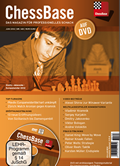
ChessBase Magazine issue 148
2012
June
http://www.chessbase.com
E-Mail
info@chessbase.com
ISSN 1432-8992
Euro 19.95
This ChessBase Magazine is well filled with super games from top
events as the European Championship and Russian Team Championship.
But you can also enjoy the third game of the Aronian – Kramnik match
where the game comments come from Vladimir Kramnik himself!
But first a fee of the excellent theory files:Mihail Marin presents the
Torre Attack with a King’s Indian set-up: 1.d4 Nf6 2.Nf3
g6 3.Bg5 Bg7 4.Nbd2 0-0 5.c3 d6 6.e4 Nbd7, Dutch A88:1.d4 f5 2.c4
Nf6 3.g3 g6 4.Bg2 bg7 5.Nf3 0-0 6.0-0 d6 7.Nc3 c6 8.d5 by Boris
Schipkov,
Caro-Kann B12:1.e4 c6 2.d4 d5 3.e5 Bf5 4.Nd2 e6 5.Nb3 Nd7 6.Nf3 a6 by
Lars Schandorf,
Sicilian B38:1.e4 c5 2.Nf3 Nc6 3.d4 cxd4 4.Nxd4 g6 5.c4 Bg7 6.Be3 Nf6
7.Nc3 0-0 8.Be2 b6 by Leonid Kritz,Sicilian B90:1.e4 c5 2.Nf3
d6 3.d4 cxd4 4.Nxd4 NF6 5.Nc3 a6 6.Be3 a5 7.Nb3 Be6 8.f3 Be7 9.Qd2 0-0
10.0-0-0 Nbd7 11.g4 b5 12.g5 b4 13.Ne2 Ne8 14.f4! a5 15.f5 Bxb3
by Denis Breder.
French Defence C11: 1.e4 e6 2.d4 d5 3.Nc3 Nf6 4.e5 Nfd7 5.f4 c5 6.Nf3
Nc6 7.be3 a6 8.Qd2 Qb6 by Alexey Kuzmin,French C15: 1.e4 e6
2.d4 d5 3.Nc3 Bb4 4.a3 Bxc3 5.bxc3 dxe4! 6.Qg4 Nf6 7.Qxg7 Rg8 8.Qh6 by
Viktor Moskalenko, Two Knights Defence C55:1.e4 e5
2.Nf3 Nc6 3.Bc4 Nf6 4.d3 Be7 5.0-0 0-0 by Darko Anic, Ruy Lopez
C96:1.e4 e5 2.Nf3 Nc6 3.Bb5 a6 4.Ba4 Nf6 5.0-0 Be7 6.Re1 b5
7.Bb3 d6 8.c3 0-0 9.h3 Na5 10.Bc2 c5 11.d4 Nd7 12.Nbd2 exd4 13.cxd4 Nc6
by Martin Breutigam,Queen’s Gambit Accepted D20:1.d4 d5
2.c4 dxc4 3.e4 e5 4.Nf3 Bb4+ 5.Nc3 exd4 6.Nxd4 by Evgeny Postny,Semi-
Slav D31:1.d4 d5 2.c4 e6 3.Nc3 c6 4.Nf3 dxc4 5.e3 b5 6.a4 Bb4
7.Bd2 a5 8.axb5 Bxc3 9.Bxc3 cxb5 10.b3 Bb7 by Michal Krasenkow ,Queen’s
Gambit D38: 1.d4 d5 2.c4 e6 3.Nc3 Nf6 4.Nf3 Bb4 5.cxd5 exd5
6.Bg5 Nbd7 7.e3 c5 8.dxc5
by Igor Stohl and at last a Semi - Slav D44: 1.d4 d5 2.c4 c6
3.Nf3 Nf6 4.Nc3 e6 5.Bg5 dxc4 6.a4 by Efstratios Grivas.
The three Opening video’s come from Alexei Shirov: 1.e4 e6 2.d4 d5
3.Nc3 Bb4 4.e5 c5 5.a3 Bxc3 6.bxc3 ne7 7.Qg4,Leonid with the
Paulsen 1.e4 c5 2.Nf3 e6 3.d4 cxd4 4.Nxd4 Nc6 5.Nc3 Qc7 6.Be3 a6 7.Qd2
Nf6 8.0-0-0 and Andrew Martin concentrates on his second part of the
Eco-French.
Other columns are King:Move by Move,Wells:
Strategy,Reeh:Tactics,Müller Endgames
{With 31 annotated endgames, training questions and eight
videos!}Knaak:Opening trap, service, a 25 page booklet in two languages
etc.
Conclusion: A must for all chess
professionals!
Deep Fritz13
2012
http://www.chessbase.com
E-Mail
info@chessbase.com
Euro 99.90
System requirements: Minimum: Minimum: Pentium III 1 GHz, 1 GB RAM,
Windows Vista, XP
(Service Pack 3), DirectX9 graphics card with 256 MB RAM, DVD-ROM
drive, Windows Media Player 9 and Internet access to activate the
program, playchess.com, Let’s Check, Engine Cloud and updates.
Recommended: PC Intel Core 2 Duo, 2.4 GHz, 3 GB RAM, Windows 7,
DirectX10 graphics card (or compatible) with 512 MB RAM or more, 100%
DirectX10 compatible sound card, Windows Media Player 11, DVD ROM drive
and Internet access to activate the program, playchess.com, Let’s
Check, Engine Cloud and updates.
The new Deep Fritz13 comes with some fascinating futures
as lets Check and “ChessBase Engine Cloud” This new function
makes it possible
to run deep position analysis, blunder searches, engine matches, etc.
using engines located on different computers.
It runs all from the playchess.com side,couple your private machine for
joint analyses it
Is all done with a few clicks with your mouse.
All new users of Deep Fritz 13will receive five ducats for spending on
engine play.
Deep Fritz13 comes with a improved version of the Fritz13 engine and it
includes a special openings book by Alex cure from over 4
million positions and a database from over 1.5 million games.It all
comes with Premium membership at Playchess.com for 12 months.
Deep Fritz13 is fast but my first testing game with Houdini 2.0cw32 did
end in a draw!
Deep Fritz13 – Houdini2.0cw32,CPU 2.40GHz 2399 mhz, 1.d4 d5 2.Nf3 Nf6
3.c4 e6 4.Nc3 Be7 5.cxd5 exd5 6.g3 0-0 7.Bg2 Re8
8.0-0 c6 9.Bf4 Nbd7 10.Qd3 Nf8 11.Ne5 Bd6 12.Rae1 Ne6 13.Bd2 Nc5
14.dxc5 Bxe5 15.e4 dxe4 16.Qxd8 Rxd8 17.Nxe4 Nxe4
18.Ba5 Rf8 19.Rxe4 Bxb2 20.Bc7 g6 21.Rb1 Bf6 22.Ree1 h5 23.h4 Kg7
24.Rb3 Rg8 25.a4 a5 26.Bf1 Bd4 27.Bd6 Ra7 28.Bc4 Bf6
29.Bb8 Ra8 30.Bc7 Rf8 31.Kg2 Rh8 32.Kg1 Rg8 and draw on move 38.
Deep Fritz13 gave me a great performance on a Intel Core 2 Quad
machine,Fritz13 digs for example in the following position to a
painstaking depth:
Fischer,Robert James (2740) - Taimanov,Mark E (2620) [B44]
Candidates Match quarterfinal3 Vancouver (6), 01.06.1971
1.e4 c5 2.Nf3 Nc6 3.d4 cxd4 4.Nxd4 e6 5.Nb5 d6 6.Bf4 e5 7.Be3 Nf6 8.Bg5
Be6 9.N1c3 a6 10.Bxf6 gxf6 11.Na3 Nd4 12.Nc4 f5
13.exf5 Nxf5 14.Bd3 Rc8 15.Bxf5 Rxc4 16.Bxe6 fxe6 17.Qe2 Rd4 18.0-0 Qg5
19.Rad1 Qf5 20.Rxd4 exd4 21.Ne4 Be7 22.Rd1 Qe5
23.Qd3 Rf8 24.Qxd4 Qxd4 25.Rxd4 d5 26.Nc3 Bc5 27.Rd2 Rf4 28.g3 Rc4
29.Ne2 Ra4 30.a3 Kd7 31.Kg2 b5 32.c3 a5 33.Nd4 b4
34.Nb3 Bb6 35.axb4 axb4 36.c4 Kc6 37.c5,Deep Fritz13 plays now the same
move as Taimanov 37….Bc7 {Bc7 38.Nd4+ Kd7
39.f4 e5 40.c6+ Kc8 41.Nb5 Ra2 42.f5 Bd8 43.Rxd5 Rxb2+ 1-0}
Interesting enough DeepFritz13 and Fritz13 prefer 39…b3 and after
40.Nxb3 Rc4 and after 41.Nd4 Ba5 42.b3 Bxd2 43.bxc4 dxc4
44.Kf3 Bb4 45.c6 Kd6 46.Ke4 Ba5 47. c7 Kxc7 48.Nxe6 Kc6 49.Kd4 c3
50.Kc4 Kd6 51.Nd4 Bb6 52.Nb5+ Ke6 53.Nxc3 is winning too.
Conclusion:This engine digs to
a painstaking depth!
Opening Encyclopaedia 2012
2012
http://www.chessbase.com
E-Mail
info@chessbase.com
Euro 99.90
System requirements:Pentium Prozessor 300 MHz or higher, 64 MB
RAM, Windows XP, Windows Vista, Windows 7, DVD-ROM drive, mouse, sound
card
This new Opening Encyclopaedia
features more chess information than all the New in Chess books and
Informators together!
First of all it comes with over 4.3 million games, where more than
80.000 of them are annotated.
It covers over 5.200 opening surveys, and for each of the ECO 500
opening sections according to the ECO standards, there is at least one
opening
survey and that makes this DVd perfect as database building tool.
Interesting to mention are the 655 special made theory databases,which
insures the user with a lot of latest theory devolpments.
Included is a openings book from all 4.3 million games and that gives
an excellent overview of statistics and more!
A lot of material comes from the well known ChessBase Magazines.
Conclusion: This Opening Encyclopaedia
is completely overloaded with latest chess developments!
 Learn from the Open
Games by Sam Collins
2012
Learn from the Open
Games by Sam Collins
2012
http://www.chessbase.com
E-Mail
info@chessbase.com
Euro 27,90
Pentium-Processor at 300 Mhz or higher, 64 MB RAM, Windows XP, Windows
Vista, Windows 7, DVD drive, mouse, soundcard.
Sam Collins explains with understandable words the strategies and
secrets of the open game,
sometimes it is a sharp Spanish Exchange as we can see in the following
model game: Turner,Matthew (2508) - Hammer,Jon Ludvig (2585) [C68]
BCF-chT 0910 (4NCL) England (11), 03.05.2010
1.e4 e5 2.Nf3 Nc6 3.Bb5 a6 4.Bxc6 dxc6 5.0-0 Bg4 6.h3 Bh5 7.g4 Bg6
8.Nxe5 Qh4 9.Qf3 f6 10.Nxg6 hxg6 11.Kg2 g5 12.Nc3 Ne7
13.e5 Ng6 14.d4 0-0-0 15.Ne2 Qh7 16.Kh2 Nh4 17.Qd3 Qxd3 18.cxd3 fxe5
19.dxe5 Rxd3 20.Be3 Rd5 21.e6 Rh6 22.Nc3 Re5
23.Kh1 c5 24.Bxg5 Rxg5 25.f4 Rgg6 26.f5 Nxf5 27.Rxf5 Bd6 28.Kg2 Rxe6
29.Raf1 b5 30.b3 Kb7 31.R1f2 Kc6 32.Ne2 Re3
33.Ng1 Rg3+ 34.Kf1 Rc3 35.Rg5 c4 36.bxc4 Bc5 37.cxb5+ axb5 38.Ne2 Rcxh3
39.Rff5 Rh1+ 40.Kg2 R6h2+ 41.Kg3 Rh3+
42.Kg2 R3h2+ 43.Kg3 Bd6+ 44.Kf3 Rf1+ 45.Ke3 Re1 46.Rf2 Rh3+ 47.Rf3 Rh2
48.Rf2 Bf4+ 49.Rxf4 Rexe2+ 50.Kd3 Rxa2
51.Rb4 Ra5 52.Rxg7 Ra3+ 53.Kd4 Kb6 54.Rg6+ c6 55.Rb1 Ra4+ 56.Ke5 Re2+
57.Kf5 Rf2+ 58.Ke5 Rff4 59.g5 Rae4+
60.Kd6 Rf5 61.Rd1 Rg4 62.Kd7 Rc5 63.Rg8 Rcxg5 64.Rb8+ Kc5 65.Rc1+ Rc4
66.Re1 Rg7+ 67.Ke6 Rg3 68.Re5+ Kb4
69.Kd6 Rg6+ 70.Kc7 Rh4 71.Rc8 c5 72.Kb7 c4 73.Rc6 Rxc6 74.Kxc6 Rh6+
75.Kd5 c3 0-1,
or as the one from the brilliant Carlsen: Carlsen,Magnus (2826) -
Nakamura,Hikaru (2758) [C54]London Classic 3rd London (3), 05.12.2011
1.e4 e5 2.Nf3 Nc6 3.Bc4 Nf6 4.d3 Bc5 5.c3 d6 6.Bb3 a6 7.Nbd2 Ba7 8.Nf1
h6 9.Ng3 0-0 10.0-0 Be6 11.h3 Qd7 12.Be3 Ne7
13.Nh4 Ng6 14.Nhf5 Ne7 15.Nxe7+ Qxe7 16.Bxa7 Rxa7 17.f4 c5 18.Bc2 b5
19.Qd2 Rb7 20.a3 a5 21.Rf2 b4 22.axb4 axb4
23.Raf1 bxc3 24.bxc3 exf4 25.Rxf4 Nh7 26.d4 cxd4 27.cxd4 Qg5 28.Kh2 Nf6
29.Bd1 Rfb8 30.h4 Qg6 31.Rxf6 gxf6 32.Qf4 Rb2
33.Bh5 Qg7 34.Bf3 Ra8 35.d5 Bc8 36.Nh5 Qf8 37.Nxf6+ Kh8 38.Rc1 Kg7
39.e5 dxe5 40.Nh5+ Kh7 41.Be4+ 1-0,yes nowadays the
modern player prefers a positional approach and moves as the
Möller Attack belong to the past.
But there is instructive open game with 6…Bb4: Jones,Gawain C (2624) -
Berczes,David (2557) [C54]
Rome Barclays op-A 1st Rome (9), 11.09.2011
1.e4 e5 2.Nf3 Nc6 3.d4 [3.Bc4 Bc5 4.c3 Nf6 5.d4 exd4] 3...exd4 4.Bc4
Bc5 5.c3 Nf6 6.cxd4 Bb4+ 7.Bd2 [7.Nc3 Nxe4 8.0-0 Bxc3
(8...Nxc3 9.bxc3 Bxc3 10.Ba3) 9.d5 (9.bxc3 d5) 9...Bf6 10.Re1 Ne7
11.Rxe4 d6 12.Bg5 Bxg5 13.Nxg5 0-0 (13...h6 14.Qe2 hxg5 15.Re1 Be6
16.dxe6 f6)
14.Nxh7] 7...Bxd2+ 8.Nbxd2 d5 9.exd5 Nxd5 10.0-0 [10.Qb3 Nce7 (10...Na5
11.Qa4+ Nc6 12.Qb3 (12.Qa3 Qe7+) )
11.0-0 0-0 12.Rfe1] 10...0-0 11.Rc1 Nb6 12.Bb3 Bf5 13.Rc5 Bg6 14.Qc1 a5
15.Qc3 a4 16.Bc4 Ne7 [16...Nxc4 17.Nxc4]
17.Ne5 Ned5 18.Qf3 c6 19.Re1 Nxc4 20.Ndxc4 Nc7 21.Nxg6 hxg6 22.Rd1 Nd5
23.Ne3 Nf6 24.h3 Qe7 25.Re5 Qb4 26.Qe2 Rfd8
27.a3 Qb3 28.Rd3 Qa2 29.Re7 c5 30.Rxb7 cxd4 [30...Rxd4] 31.Qd1
Rdb8 32.Rxb8+ Rxb8 33.Rxd4 Rxb2 34.Qxa4 Rb1+ 35.Rd1 Rb8
36.Qa5 Re8 37.Rd8 Rxd8 38.Qxd8+ Kh7 39.Qd3 Qa1+ 40.Nf1 Qa2 41.Qf3 Nd7
42.Qe3 Qa1 43.Qb3 f5 44.Qb4 Nf6 45.a4 Ne4
46.a5 Nc3 47.Qh4+ Kg8 48.Qc4+ Kh7 49.a6 Ne4 50.f3 Nf6 51.Qb5 Nh5
52.Kh2 f4 53.h4 Qe1 54.a7 Ng3 55.Nxg3 fxg3+
56.Kh3 Qe6+ 57.Kxg3 Qe1+ 58.Kf4 Qxh4+ 59.g4 Qh2+ 60.Ke4 Qc2+ 61.Ke3
Qc3+ 62.Ke2 Qc2+ 63.Kf1 Qd1+ 64.Kg2 Qd2+
65.Kh3 Qh6+ 66.Kg3 Qe3 67.a8Q Qg1+ 68.Kf4 Qd4+ 69.Qe4 Qd2+ 70.Kg3
1-0,all strategies as open lines,attacks,gambits etc are all well
covered by the instructive speaking
Collins.
Video running time: 4 hours
Conclusion: This DVD really helps you
to play and understand the startegies of the Open Game!
 The Queen’s Gambit
Accepted: A Repertoire for Black by Sam Collins
2012
The Queen’s Gambit
Accepted: A Repertoire for Black by Sam Collins
2012
http://www.chessbase.com
E-Mail
info@chessbase.com
Euro 27,90
Pentium-Processor at 300 Mhz or higher, 64 MB RAM, Windows XP, Windows
Vista, Windows 7, DVD drive, mouse, soundcard.
Sam Collins provides the user of this DVD with a repertoire line for
black based on the Queen’s Gambit Accepted with the line 1.d4 d5 2.c4
dxc4
3.Nf3 Nf6 4.e3 Bg4 and after
5.Bxc4 e6 6.h3 Bh5 7.0-0 Nbd7 8.Nc3 Bb4.
4….Bg4 is a very logical continuation and it belonged to one of the
favourite lines of the great David Bronstein,but Tony Miles knew his
way with it
as we can see in the following model game: Najdorf,Miguel (2515) -
Miles,Anthony J (2560) [D25]
Konex Buenos Aires (10), 1979
1.Nf3 d5 2.d4 Nf6 3.c4 dxc4 4.e3 Bg4 5.Bxc4 e6 6.0-0 Nbd7 7.h3 Bh5
8.Be2 Bd6 9.Nbd2 0-0 10.Nc4 Nb6 11.Nfe5 Bxe2 12.Qxe2 Nfd7
13.Nxd7 Qxd7 14.b3 Nxc4 15.Qxc4 e5 16.Bb2 e4 17.d5 Rae8 18.Rad1 f5
19.f4 exf3 20.Rxf3 Re4 21.Rd4 Rfe8 22.Rxe4 fxe4 23.Rf1 Qe7
24.Ba3 h6 25.Bxd6 cxd6 26.Rf4 Qe5 27.a4 a6 ½-½,Tony was
at that time only 22 years old.
Going throw these excellent made video files will help you to play and
understand the Queen’s Gambit Accepted.
Running time: 3 hours 30 min
Conclusion: Very instructive explained!
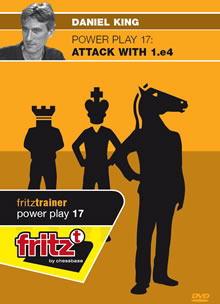
Power Play 17 - Attack with 1.e4 by Daniel King
2012
http://www.chessbase.com
E-Mail
info@chessbase.com
Euro 29,99
Pentium-Processor at 300 Mhz or higher, 64 MB RAM, Windows XP, Windows
Vista, Windows 7, DVD drive, mouse, soundcard.
Grandmaster Daniel King provides you in two languages, German
and English the secrets of a good attack with 1.e4, against moves
as 1...e5, the Sicilian, French, and Caro Kann.
On 1.e4 e5 King prefers the good Old Italian game with the move d3,
Kasparov,Garry (2805) - Matabeek,Sunil [C54]Internet sim1
ICC INT, 04.12.1995
1.e4 e5 2.Nf3 Nc6 3.Bc4 Bc5 4.c3 Nf6 5.d3 [5.d4 exd4 6.cxd4 Bb4+ 7.Bd2
Bxd2+ 8.Nbxd2 d5 9.exd5 Nxd5] 5...d6 6.Bb3 Bg4 7.h3 Bh5
[7...Bxf3 8.Qxf3] 8.Nbd2 h6 9.Nf1 0-0 10.g4 Bg6 11.Ng3 Re8 12.g5
Nh5 [12...hxg5 13.Bxg5 (13.Nxg5 Na5 14.Bc2 Bb6 15.h4
(15.b4 Nc6 16.Bb3 Qd7 17.h4 Ng4 18.h5 Bxf2+ 19.Kf1 Bh7 20.h6 Bxg3
21.Bxf7+ Qxf7+ 22.Nxf7 Nf2 23.Qb3 Nxh1 24.Ng5+)
15...Nh7 16.Nf3 f6 17.h5 Bf7 18.Nf5) 13...Na5 14.Nh4 (14.Bc2) 14...Nxb3
15.Qxb3 Bh7 16.Rg1 Kh8 17.Nh5 d5] 13.Nh4 Nxg3
14.fxg3 Kh7 15.gxh6 gxh6 16.Rf1 Rf8 17.Qg4 Qc8 18.Nf5 Bxf5 19.Rxf5 Ne7
20.Qh5 Nxf5 21.exf5 Qd8 22.Qxh6+ Kg8 23.f6 Qxf6
24.Qxf6 1-0,against the Sicilian King goes for the great Grand Prix
Attack 2.f4,
Against the French: 1.e4 e6 2.d4 d5 3.Nc3 Bb4 4.exd5 exd5 5.Bd3 Nc6
6.a3 Bxc3+ 7.bxc3 Nge7 8.Qf3 and the Caro-Kann is handeld
with the Exchange Variation but as we can see in the following games it
is not with out danger!
Fischer,Robert James - Petrosian,Tigran V [B13]
Belgrade URS-World Belgrade (1.2), 29.03.1970
[Bulletin]
1.e4 c6 2.d4 d5 3.exd5 cxd5 4.Bd3 Nc6 5.c3 Nf6 6.Bf4 [6.h3 e5
Fischer=:F;
6.Bg5 Ne4 7.Bxe4 dxe4 8.d5 Ne5 9.Qa4+ Qd7 10.Qxe4 Qf5³ F] 6...Bg4
[6...g6 Petrosian=:P] 7.Qb3 Na5 [¹7...Qc8 § h5, g6 Hort]
8.Qa4+ Bd7 9.Qc2 e6 [9...a6 P] 10.Nf3 Qb6 § b5 11.a4!N Fischer's
new move, which prevents 11.. d7-b5 exchanging the bad d7
with the very good d3. [11.0-0 Bb5 12.Nbd2 Bxd3 13.Qxd3 Rc8 14.Rab1 Be7
15.h3 0-0 16.Rfe1 Nc4 17.Nxc4 Rxc4 18.Ne5 Rcc8
19.Bg5 Qd8 20.Bxf6 gxf6 (20...Bxf6 21.f4) 21.Ng4 Kh8 22.f4 f5 23.Ne5
Bd6 24.Qf3 Bxe5 25.Rxe5 Rg8 26.Re2 Qh4 27.Kh2 Rg6
28.g3 Qf6 29.Rg1 Kg7 30.Qd3 a6 31.Rc1 h5 32.h4 Kh6 33.c4 dxc4 34.Rxc4
Rxg3 35.Qxg3 Rxc4 36.Rd2 Qg6 37.Qg5+ Qxg5
38.hxg5+ Kg6 39.Kg3 Rc6 40.Kf3 Rd6 41.Kg3 f6 42.gxf6 Kxf6 43.Kf3 h4
44.Rh2 Rxd4 45.Rxh4 b5 46.Rh6+ Ke7 47.Rh7+ Kd6
48.Ra7 Ra4 49.a3 Kd5 0-1 Maroczy,G-Capablanca,J/Lake Hopatcong
1926/HCL] 11...Rc8 [¹11...Nb3 12.Ra2 Rc8 13.0-0 Be7 F
14.Nbd2;
11...Qb3 12.Qe2! Bxa4? 13.Rxa4 Qxa4 14.Bb5++- F] 12.Nbd2 Nc6 13.Qb1 Nh5
[¹13...g6 F;
13...Be7 14.0-0 0-0 15.Ne5] 14.Be3 h6 [14...f5 15.g4! fxg4 16.Ng5 Bd6
17.Bxh7 F;
14...g6 P] 15.Ne5 Nf6 [15...Nxe5 16.dxe5 Bc5 17.a5 Qc7 18.Nf3 F(18.g4
Bxe3 19.fxe3 Qxe5 20.gxh5 Qxe3+ 21.Be2 Bb5
22.Qd1 § f1-g3 P) ] 16.h3 Bd6 17.0-0 Kf8 [¹17...0-0 F] 18.f4
Be8 [18...Nxe5 19.fxe5 Bxe5 20.a5+- F] 19.Bf2! F 19...Qc7
[19...g6 20.f5 gxf5 21.Bxf5 exf5 22.Qxf5 Qd8 23.Bh4+- F] 20.Bh4 Ng8
21.f5 Nxe5 22.dxe5 Bxe5 23.fxe6 Bf6 24.exf7 Bxf7 25.Nf3!
F 25...Bxh4 [25...g5 26.Bf2 Kg7 27.Bd4 F] 26.Nxh4 Nf6 27.Ng6+
Bxg6 28.Bxg6 Ke7!! F 29.Qf5 Kd8 30.Rae1 Qc5+ 31.Kh1 Rf8+- F
[¹31...Rc6 F/P;
31...Kc7 32.b4 Qd6 33.Re6] 32.Qe5! F/P 32...Rc7 [32...Qc7 33.Qxd5++-
F(33.Rxf6!+-) ] 33.b4! F 33...Qc6 34.c4! F 34...dxc4
35.Bf5 Rff7 36.Rd1+ Rfd7 37.Bxd7 Rxd7 [37...Nxd7 38.Rfe1+- F/P] 38.Qb8+
Ke7 [38...Qc8 39.Rxd7+ Nxd7 40.Qd6+- F] 39.Rde1+ [39.Rde1+ Kf7 40.Qe8#]
1-0.
All together we have here a unbelievable instructive DVD!
Video running time is a impressive 6 hours.
Conclusion: Super instructive learning material!
First Steps in Chess Technique by Andrew Martin
2012
http://www.chessbase.com
E-Mail
info@chessbase.com
Euro 19,90
Pentium-Processor at 300 Mhz or higher, 64 MB RAM, Windows XP, Windows
Vista, Windows 7, DVD drive, mouse, soundcard.
Andrew Martin goes back to the basics of good understanding and
explains in a instructive way the moves and strategies that
lays behind it.
The games are highly instructive as we can see in the following model
game:
Svidler,Peter (2739) - Lima,Darcy (2493) [C18]
FIDE World Cup Khanty Mansiysk (1.2), 29.08.2011
[,Andrew] My first game this month comes from the FIDE World Cup and
features a system of play from Black in the
French Winawer which has experienced a great deal of popularity in
recent years. 1.e4 e6 2.d4 d5 3.Nc3 Bb4 4.e5 c5
5.a3 Bxc3+ 6.bxc3 Qa5!? 7.Bd2 Qa4
rnb1k1nr/pp3ppp/4p3/2ppP3/q2P4/P1P5/2PB1PPP/R2QKBNR w KQkq - 0 0
If Black can get away with it and he will if White responds slowly, the
Queen is very well placed on a4, gumming up the
White queenside and preparing ....b7-b6 and ...Ba6, getting rid of the
bad Bishop. Of course this all costs time.
Battle is joined. 8.Qb1 [8.Qg4 Kf8] 8...c4 Please do not allow Bb5+
9.h4 With the centre frozen it is logical to begin flank
operations. The struggle slows down. 9...Nc6 10.h5 h6 11.Nf3 Bd7 12.g3!
0-0-0 13.Bh3 Nge7 14.0-0 Rdf8 15.Re1
2k2r1r/pp1bnpp1/2n1p2p/3pP2P/q1pP4/P1P2NPB/2PB1P2/RQ2R1K1 b - - 0 0
Svidler stations his pieces very carefully, awaiting action from Black
on the kingside. If Black does nothing, White may even fashion a
kingside pawn roller. The problem as I see if from Black's perspective
is that his position is prospectless if he does not act on the
kingside. 15...g5 16.Nh2 [16.hxg6 fxg6] 16...f5 But, of course, playing
such moves brings the White bishop pair into the game.
17.exf6 Ng8 [17...Rxf6 is reasonable: 18.Ng4 Rf7 19.Qb2 Nf5 20.Rab1 b6
21.Ne5 Nxe5 22.Rxe5 Rhf8 23.Bg4 Nd6 Black
has marshalled his pieces successfully.] 18.Bxe6 Bxe6 19.Rxe6 Nxf6
20.Qd1 Kb8
1k3r1r/pp6/2n1Rn1p/3p2pP/q1pP4/P1P3P1/2PB1P1N/R2Q2K1 w - - 0 0
A complex situation. Somehow White needs to get through to Black's
seventh rank in order to make progress,but the Knight on
c6 is a very effective piece. 21.g4 [21.Ng4 Nxg4 22.Qxg4 Qxc2 23.Re2
Qd3 24.Rae1 a6 25.Qe6 is the sort of sequence
White should be looking at, giving up a pawn to get organised. But even
here, it is not easy to break Black's defence and
White's King is also a bit shaky: 25...Qf3! 26.Qd6+ Ka7 27.Qc5+ Ka8
28.Qd6 Rf6 29.Qd7 Rd8 30.Qg7 Rdf8÷] 21...
Ne8 22.Nf1 Nc7 23.Re1 Rh7 24.Ng3 Ne7 25.Re3 Rhf7 26.f3 Nc8 27.Kg2 Nd6
28.Be1 Re8 29.Nf1
1k2r3/ppn2r2/3n3p/3p2pP/q1pP2P1/P1P1RP2/2P3K1/R2QBN2 b - - 0 0
This is the type of position that 99% of chessplayers find incredibly
difficult to handle. White knows he has to press on the
dark squares and prove that his Bishop is a good piece .If he succeeds,
he will have Black at his mercy. White also has the
possibility of creating a passed pawn on the kingside. These are his
twin aims.
Black knows in order to frustrate White's plans, he must keep
coordinated in the centre and aim for endgames where his pressure
on the queenside will carry the day.
It is heavy going. 29...Ne6 30.Bg3 Nf4+ 31.Kg1 a6 32.Qd2 Ref8 33.Re5
Ka7 34.Ne3 Nb5 [34...Nxh5! 35.gxh5 Rxf3 is certainly
an interesting possibility: 36.Kg2! (36.Qh2 Ne4
5r2/kp6/p6p/3pR1pP/q1pPn3/P1P1NrB1/2P4Q/R5K1 w - - 0 0
This seems very good for Black to me. Maybe White can bail with 37.Rxe4
dxe4 but no way is White better here: 38.Bd6 (38.Ng4?! Qa5
39.Rd1 e3 40.Be5 Rf2 41.Nxf2 exf2+ 42.Kf1 Qxc3µ) 38...R8f4!
39.Bxf4 (39.Rf1 Rxe3 40.Rxf4 gxf4 41.Qxf4 Re1+ 42.Kf2 Rb1 43.Bc5+ b6
44.Qc7+=)
39...gxf4 40.Nd5 Qa5-+) 36...Ne4 37.Rxe4 dxe4 38.d5 Qd7 39.Qd4+
Ka8 40.Qxe4 Qf7 41.Ng4÷] 35.Kh2 Rf6 36.Re7 Qa5 37.Be1 Qd8 38.Re5
Nd6
39.Bg3 Nf7 40.Rf5! White breathes a sigh of relief after the
exchange of a pair of Rooks. Without direct pressure on his King, he
can get on with his general
plans. 40...Nd6 41.Rxf6 Qxf6 42.Re1 Nb5 43.a4 Nc7 44.Nf5 Nce6
45.Re5± Rc8 46.Qc1 Rc6 47.Qa3
8/kp6/p1r1nq1p/3pRNpP/P1pP1nP1/Q1P2PB1/2P4K/8 b - - 0 0
This phase of the game is nicely played by Svidler. Black has not
managed his counterplay well enough and White is now in total control.
47...Nc7 48.Ne7 Re6 49.Qc5+ Kb8 50.Nxd5! Ncxd5 51.Qxd5 The Bishop on g3
is the killer piece. Who would have believed it?
51...Rxe5 [51...Nxd5 52.Rxe6+] 52.dxe5 The struggle in the Winawer
remains as difficult as ever. 52...Nxd5 53.exf6+ 1-0.
Video running time: 3 hrs 35 min.
Conclusion: Andrew Martin really helps you to play and understand
chess!

Winning with the Ruy Lopez Vol. 1: Berlin Wall and
others by Viktor Bologan
2012
http://www.chessbase.com
E-Mail
info@chessbase.com
Euro 29,90
Pentium-Processor at 300 Mhz or higher, 64 MB RAM, Windows XP, Windows
Vista, Windows 7, DVD drive, mouse, soundcard.
Grandmaster Victor Bologan provides the reader with a repertoire
for white against the Ruy Lopez,and on his first DVD he meets the
Spanish with
out the move 3…a6.
And that included rare lines as the Schliemann Defence 3…f5 ,The
Classical Defence 3…Bc5,The Bird’s Defence 3…Nd4,The Cozio
Variation 3…Nge7,Smyslov Variation 3…g6,Steinitz Defence 3….d6,The
Classical Berlin Defence and at last a detailed coverage of the Berlin
Wall!
About the Wall I found a mass of variation that easy can stand-up books
as The Berlin Defence from Lysyj & Ovetchkin or the more outdated
Berlin Wall from John Cox.
Bologan his material is split-up in lines as 1.e4 e5 2.Nf3 Nc6 3.Bb5
Nf6 4.0-0 Nxe4 5.d4 Nd6 6.Bxc6 dxc6 7.dxe5 Nf5 8.Qxd8+ Kxd8 9.Nc3
Ke8 10.h3 h5 11.Bg5 Be6 12.a3 Be7 13.Rad1 Rd8 14.Rxd8+ Kxd8 15.Rd1+ Ke8
16.Bxe7 Kxe7 17.Ng5 h4 18.Ne2 Rh5 19.Nxe6 fxe6
20.Rd3 or 1.e4 e5 2.Nf3 Nc6 3.Bb5 Nf6 4.0-0 Nxe4 5.d4 Nd6 6.Bxc6 dxc6
7.dxe5 Nf5 8.Qxd8+ Kxd8 9.Nc3 Ne7 10.h3 h6 [10...Bf5
11.Nd4 Bg6 12.f4 c5 13.Nf3 Bxc2 14.g4 h5 15.Ne1 Bh7 16.f5 g6 17.f6;
10...Ng6 11.Bg5+ Ke8 12.Rad1 Bd7 (12...Be7 13.Bxe7 Kxe7 14.Nd4 Nf4
15.Kh2 Rd8 16.g4 h5 17.Kg3 Nxh3 18.e6) 13.Rd2 Be6 (13...Be7
14.Bxe7 Kxe7 15.Nd4 Nf4 16.Kh2 h5 17.g3) 14.Rfd1 Be7 15.Ne4 Bd5 16.Re1
Bxg5 17.Nexg5 h6 18.Ne4 Rd8 19.Kh2 Nf4 20.Kg3 Ne6 21.Nh4]
11.Be3 Ke8 [11...Nd5 12.Rad1 Be6 13.Nd4 Bd7 (13...Nxe3 14.fxe3 Ke8
15.Nxe6 fxe6 16.Ne2 Bc5 17.Rf3 h5 18.Nf4 Rh6 19.Rg3) 14.Bd2 Bc5
15.Nb3 Be7 16.Ne4 Ke8 17.Rfe1 Be6 18.Nd4;
11...Bf5 12.Rad1+ Kc8 13.g4 Bxc2 14.Rd2 Bh7 15.Rfd1;
11...Bd7 12.Rad1 Kc8 13.Rd2 b6 14.Rfd1 Be6 15.Nd4 Nd5 (15...Bc4)
16.Nxe6 fxe6 17.Ne4;
11...Ng6 12.Rad1+ Ke8 13.a3 Be7 14.Rfe1 h5 15.Nd4 h4 16.f4 Rh5 17.Ne4
Bd7 18.c4 b6 19.b4 Nf8
(19...a5 20.c5 axb4 21.axb4 bxc5 22.bxc5) 20.f5 c5 (20...Bxf5 21.g4)
21.f6 gxf6 22.exf6 cxd4 23.fxe7] 12.Rad1 Bd7
[12...Be6 13.Nd4 Nd5 14.Nxd5 Bxd5 15.Nb5] 13.Rfe1 Rd8 14.Ne4 Bf5
[14...b6 15.Nf6+ gxf6 16.exf6 Nd5
17.Bd4+ Be6 18.Rxe6+ fxe6 19.f7+] 15.Nc5 b6 16.Na6 Nd5 17.c4 Nxe3
18.Nxc7+ Ke7 19.fxe3 Rd7 20.Na6.
Video running time: 4 hours and 42 minutes.
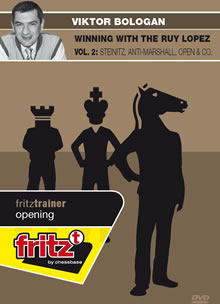
Winning with the Ruy Lopez Vol. 2: Steinitz,
Anti-Marshall by Viktor Bologan
2012
http://www.chessbase.com
E-Mail
info@chessbase.com
Euro 29,90
Pentium-Processor at 300 Mhz or higher, 64 MB RAM, Windows XP, Windows
Vista, Windows 7, DVD drive, mouse, soundcard.
GM Viktor Bologan shows us on his second DVD how he handles all
lines that arise after
The moves 1.e4 e5 2.Nf3 Nc6 3.Bb5 a6 4.Ba4 a6 5.Ba4 and that includes
the Open Lopez
4…Nf6 5.0-0 Nxe4 which was a favourite of the famous Dr.Tarrasch
1862-1934 who believed so much in active piece play.
But also the Steinitz Defence 3…d6 is covered, but I enjoyed it most
the sharp Anti Marshall lines as 1.e4 e5 2.Nf3 Nc6 3.Bb5 a6 4.Ba4 Nf6
5.0-0 Be7 6.Re1 b5 7.Bb3 0-0 8.h3 d5 9.exd5 Nxd5 10.Nxe5 [10.d3 Bf6
(10...Bb7 11.Nxe5 Nxe5 12.Rxe5 Bf6 (12...Qd6 13.Re1 Rae8
14.Nd2 Qg6 15.Qg4; 12...c5 13.Qf3) 13.Re1 c5 14.Nd2 Nf4 15.Ne4) 11.Nbd2
h6 12.Ne4 Be7 13.Ng3 Bf6 14.Nh5] 10...Nxe5 11.Rxe5 Nb6
[11...c6 12.d3 Bd6 13.Re1 Bc7 14.Nd2 Qd6 15.Nf1 Bb7 16.Qf3 Rab8 17.Qg3
Qd7 18.Qg4 f5 19.Qg5] 12.d3 c5 13.c3 Bd6 14.Re1 Bc7
15.Nd2 Qxd3 16.Ne4 c4 [16...Qxd1 17.Bxd1 c4 18.Bf3 Rb8 19.Be3 Rd8
20.Rad1 Rxd1 21.Rxd1 h6 22.Rd2 a5 23.Nc5 b4 24.g4 Kf8
25.Bc6] 17.Qxd3 cxd3 18.Nc5 Bf5 19.g4 Bg6 20.f4 Nc4 21.Bxc4 Bb6 22.Be3
d2 23.Red1 bxc4 24.Bf2 Bxc5 25.Bxc5 Rfc8 26.Bf2 and
1.e4 e5 2.Nf3 Nc6 3.Bb5 a6 4.Ba4 Nf6 5.0-0 Be7 6.Re1 b5 7.Bb3 0-0 8.h3
Bb7 9.d3 h6 [9...Re8 10.a3 (10.Ng5 Rf8 11.Nf3; 10.Nc3 Bb4)
10...h6 11.Nbd2 Bc5 12.c3 Bb6 13.Ba2 d6 (13...d5 14.exd5 Nxd5 15.Ne4)
14.Nf1 d5 15.exd5 Nxd5 16.Ng3 Nf6 17.Nh4] 10.Nc3 Re8
[10...Bc5 11.Bd2 d6 12.Ne2 Bb6 (12...Re8 13.Ng3) 13.c3 Na5 14.Bc2 d5
15.exd5 Qxd5 16.Ng3 Rfe8 17.Qc1] 11.Bd2 Bc5 [11...Bf8
12.Nd5 d6 13.a4 Nb8 14.Nxf6+ Qxf6 15.Nh2] 12.Nd5 Nd4 [12...d6
13.a4 Nd4 14.Nxd4 Bxd4 15.c3 Bc5 16.Nxf6+ Qxf6 17.Be3 Bxe3
18.Rxe3] 13.Nxd4 Bxd4 14.c3 Bc5 15.Nxf6+ [15.Qf3 Nxd5 16.Bxd5
Bxd5 17.exd5 d6 18.Re4 Rf8 (18...Qd7 19.Rae1 f5 20.R4e2
Bb6 21.d4 exd4 (21...e4) 22.Re6 Qf7 23.h4 Rac8 24.h5) 19.Rg4 Kh7 20.Qg3
Qf6 21.Be3 Bxe3 22.fxe3 g5 23.h4 Rg8 24.Rf1 Qg6
25.e4] 15...Qxf6 16.Be3 d6 17.Qh5 Rf8 18.Bxc5 dxc5 19.Re3 Rad8 20.Rf3
Qe7 21.Re1.
yes the move 8.h3 in the Ruy Lopez is almost never a waste of time.
Running time is 5 hours and 20 minutes.
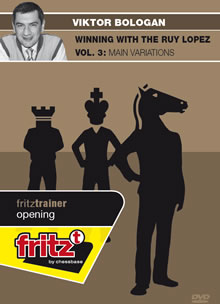 Winning with the Ruy
Lopez Vol. 3: Main Variations by Viktor Bologan
2012
Winning with the Ruy
Lopez Vol. 3: Main Variations by Viktor Bologan
2012
http://www.chessbase.com
E-Mail
info@chessbase.com
Euro 29,90
Pentium-Processor at 300 Mhz or higher, 64 MB RAM, Windows XP, Windows
Vista, Windows 7, DVD drive, mouse, soundcard.
Grandmaster Viktor Bologan reveals in this third DVD again his secrets
of the Ruy Lopez.
So this DVD goes much further than a explanation of strategies and
lines,here the user is invited into the complex of variations, but
again all
understandable explained.
Bologan handles all kind of possibilities after the moves: 1.e4 e5
2.Nf3 Nc6 3.Bb5 a6 4.Ba4 Nf6 5.0-0 Be7 6.Re1 b5 7.Bb3 d6 8.c3 0-0 9.h3
and that
includes the Breyer Variation with 9….Nb8,the Romanishin
Variation: 1.e4 e5 2.Nf3 Nc6 3.Bb5 a6 4.Ba4 Nf6 5.0-0 Be7 6.Re1 b5
7.Bb3 d6 8.c3 0-0
9.h3 Na5 10.Bc2 c5 11.d4 Bb7,Keres variation: 1.e4 e5 2.Nf3 Nc6
3.Bb5 a6 4.Ba4 Nf6 5.0-0 Be7 6.Re1 b5 7.Bb3 d6 8.c3 0-0 9.h3 Na5 10.Bc2
c5
11.d4 Nd7,which often ends around move 30 or so as we can see in the
following main line:12.Nbd2 exd4 13.cxd4 Nc6 14.d5 Nce5 15.a4 Bb7
16.Nxe5 Nxe5
17.f4 Ng6 18.Nf3 Bh4 19.Rf1 Bg3 20.f5 Ne5 21.Ng5 Nd7 22.axb5 axb5
23.Rxa8 Qxa8 24.Nxh7 Kxh7 25.f6 g6 26.e5 Kg8 27.e6 Ne5 28.Qd2 Bh4
29.Qh6 Bxf6 30.Rxf6.
The same with The Classical variation: 1.e4 e5 2.Nf3 Nc6 3.Bb5 a6 4.Ba4
Nf6 5.0-0 Be7 6.Re1 b5 7.Bb3 d6 8.c3 0-0 9.h3 Na5 10.Bc2 c5 11.d4 Qc7
12.Nbd2 Bd7 13.Nf1 Nc4 14.b3 Nb6 15.Ne3 c4 16.bxc4 Nxc4 17.Nxc4 bxc4
18.Ba3 Rfe8 19.Qd2 Rab8 20.Rad1 Bf8 21.Bb4 Bc6 22.Qc1 Qb7
23.d5 Bd7 24.Qa3.
In the Zaitsev Main Line Bologan prefers 18.exf5 {1.e4 e5 2.Nf3 Nc6
3.Bb5 a6 4.Ba4 Nf6 5.0-0 Be7 6.Re1 b5 7.Bb3 d6 8.c3 0-0 9.h3 Bb7 10.d4
Re8
11.Nbd2 Bf8 12.a4 h6 13.Bc2 exd4 14.cxd4 Nb4 15.Bb1 c5 16.d5 Nd7 17.Ra3
f5 18.exf5 Nf6 19.axb5 axb5 20.Ne4 Bxd5 21.Rxa8 Bxa8
22.Nxf6+ gxf6 23.Re6}and Khalifman’s 18.Nh2.
18.exf5 comes the two Kasparov – Karpov games and is nowadays hardy
seen anymore.
Included on this DVD are all kind of alternatives and side lines.
I would like to end with the 17…c4 Zaitsev: 1.e4 e5 2.Nf3 Nc6 3.Bb5 a6
4.Ba4 Nf6 5.0-0 Be7 6.Re1 b5 7.Bb3 d6 8.c3 0-0 9.h3 Bb7
10.d4 Re8 11.Nbd2 Bf8 12.a4 h6 13.Bc2 exd4 14.cxd4 Nb4 15.Bb1 c5 16.d5
Nd7 17.Ra3 c4 18.axb5 axb5 19.Nd4 Rxa3 20.bxa3 Nd3
21.Bxd3 cxd3 22.Re3 Nc5 23.Bb2 Qa5 24.h4 Na4 25.Ba1 Nc3 26.Bxc3 Qxc3
27.Nxb5 Qc5 28.a4 f5 29.Rxd3 fxe4 30.Rc3 with better play.
Video running time: 5 hours!
Conclusion: All covered in dangerous
depth!












